I get excited about the strategy of remarketing.
A prospective client flew down to Houston to meet with me a few weeks ago. I rambled on about search networks, display networks, social network advertising, and then I got to remarketing. When I came up for air, he said “Wow, you’re really into this remarketing shit.”
He wasn’t the first person to tell me that – not even the first person that week.
By the end of this post, I hope you’ll be just as fired up about remarketing. Whatever your business model, I want you to walk away with at least one strategy to immediately implement.
While I’ll be speaking in terms of Google Adwords remarketing, there are many services that provide behavior advertising, and the same strategies can apply.
What Everyone Already Knows About Retargeting
You visit a website, you leave, and then you see their ads for weeks on nearly every website you visit – that’s what we think of when we think of remarketing.
One day I checked out volusion.com. Now, everywhere I go online, I see Volusion ads. This ad isn’t directly targeting the domain city-data.com, it’s targeting me (more specifically, my browser).
There’s Much More You Can Do
While showing your ads to every person who visits your website can work in some scenarios, it won’t work for every business model.
If you sell a product like baby diapers, you don’t want to show diaper ads to someone who just purchased your product. That will decrease your click-through rate, which could lower your quality scores and cost you money in CPC. Even worse, this may cause your ads to get beaten by competitor’s ads in the auction more frequently.
If you’re an online retailer selling everything from shoes to skinny jeans to hockey sticks, you either have to cram all of your products into a 300×250 sized ad or keep your message so generic that it misses out on the beauty of behavioral advertising altogether. This renders your ads as highly targeted as a garage sale sign.
There’s a better way.
It’s all about lists
To get started, you’ll need to brainstorm.
- Create a list of all actions taken by users on your site.
- Determine which actions you should create unique ads for.
- Create remarketing lists that capture these individual groups separately.
- Create ads that speak to what makes them different.
Let’s look at some great list examples.
Shopping Cart Abandonment
Seewhy.com reports a staggering 78% abandonment on purchases between $0 – $100. Why do people abandon?
- 44% thought shipping and handling costs were too high
- 41% were not ready to purchase the product
- 27% wanted to compare prices
- 25% found the product price was higher than their budget
- 24% just wanted to save for later purchase
Remarketing by creating a shopping cart abandonment list allows you to target ONLY that 78% with a specific message.
Price was an issue? Do the math. Does it cost you more to pay their shipping, or to acquire a new customer? If it’s the latter, it’s a no-brainer. Give only those who abandoned a discount coupon or free shipping.
Not ready to purchase? Show them your ads for another week, with an impression cap of a few views per day.
Saving for a later purchase? Great, when that time comes they won’t have any trouble finding you.
Here’s an easy way to express the shopping cart abandonment remarketing formula:
Existing cookie represents the rule you set for the cookie. Positive/Negative existence of that cookie sets the criteria for whether they are on or off the list. The positive for /shopping-cart says that you only want people who received this cookie.The negative says that you don’t want anyone who has the cookie they received from the /thank-you-page. This leaves in your audience only visitors who were positive on the shopping cart and negative on the thank-you page. Voila, only your shopping cart abandoners fit these criteria.
The expiration date represents how long you allow the cookie to exist. After a visitor receives each cookie, the cookie will exist for the length of time you choose. Once expired, the user will be removed from the remarketing list because positive for /shopping-cart will no longer be true. Currently in Adwords, you can set a cookie expiration date for up to a year and a half.
So you have a single tag on all pages. You create two page-based rules for /shopping-cart and /thank-you-page. Then you create a combination rule based on those two page-based rules.
Here’s what this combination looks like in Adwords:
Once completed, here’s how your remarketing lists should look:
Now your list size will populate with all the visitors who abandon a shopping cart. To protect the privacy of those on the list, the list size must reach 100 before you can begin showing them ads. Consequently, you shouldn’t wait until you have a brilliant idea for an ad campaign – start populating your lists now.
Bonus Tip: If an ad group targeting any of your remarketing audiences is set for automatic placements on the display network, you’ll get a clear picture of what websites your audience visits. Pretty cool for setting up direct ad buys, contests, co-promotions, or guest posts.
Product-based Shopping Cart Abandonment
What if you could not only target those who abandoned your shopping cart, but show ads for the exact product they put in their shopping cart? Crazy, right?
Here’s the formula:
This time, instead of making the rule that someone must visit only the /shopping-cart page, you’re creating a rule-based list. The rule is that they must visit both the /grumpy-cat-shirt page and the /shopping-cart page in order to receive this cookie. Same as before, the /thank-you page removes them from the list so they will no longer see Grumpy Cat shirt ads after they purchase.
Now, instead of showing this group ads with free shipping or discounts, you can show them the exact product they put in their cart and make special offers according to your profit margins of that exact product. Remember, only those who abandon the cart will see these specials.
Here is how you define this list:
Now you create the custom combination according to the formula, like this:
And here is how it looks alongside your other lists:
Create an ad group with Grumpy Cat ads, change the targeting to include this remarketing list, and you’re good to go.
Bonus Tip: If your shopping cart dynamically generates URL parameters based on what is in your cart, this makes things much simpler. Your custom combination would then be: Positive for landing on the shopping cart url with the Grumpy Cat parameter in it, and negative for the /thank-you-page.
Anniversaries and seasonality
Remember how your cookie can last up to a year and a half before it expires? This allows you to set up seasonal remarketing lists.
Here is the formula for anniversaries and seasonality:
In the above formula, everything should look similar to the product-based abandonment scenario except for what looks like a duplicate /thank-you list in the combination.
You need to create a new remarketing tag, unique from the main tag that you’ve been setting rules for up until now. This places two different tags on the thank-you page that are unique. One of those tags places a cookie set to expire in 370 days (let’s call it Tag 1), the other places a cookie set to expire in 360 days (let’s call it Tag 2).
For the first 360 days, Tag 2 is positive, and exists as a cookie in the browser. Due to your custom combination, this does not fit the above formula, so they don’t see the ads. On day 361, Tag 2 goes inactive, making the formula true. Tag 1 is active until day 370, at which time it expires. This gives you about a 10-day window 360 days after the purchase of a product (5 days before the anniversary of when they purchased) so you’re catching them in the shopping phase.
30-day trials
Many online services offer 30-day trials. Wouldn’t it be great to advertise only to those who signed up for the trial a few days before their 30 days are up?
I’m sure many of you do what I do: sign up for a trial, tinker for an hour, and don’t touch the damn thing until you receive an email telling you to pay for it. Pay for it? I barely know what it can do!
This, and the chance that you could forever hit their spam folder, makes remarketing a great sales supplement in this situation.
Here’s the formula for 30-day trials:
Someone signs up by hitting your /trial confirmation page. Again, you need to create a unique tag for the second /trial cookie. For 25 days, the scenario won’t be true, because both /trial cookies will exist. On day 25, one of those /trial cookies will die, making the formula true. This allows you to show specific ads to only those who signed up for your trial, 5 days before their trial expires.
Maybe you rotate through ads of various features, value propositions, or testimonials of happy customers. Maybe they simply need to be reminded to tinker around a bit, so they can make an educated decision before they are booted out of the trial on day 30.
Bonus Tip: Create a duplicate of this formula, but shift the cookies from 30/25/30 to 35/30/35, and now you can offer discounts to those who let their trials expire. Worth a shot, right?
Targeting offline customers (Say what?)
Yes, you read that right. You can meet someone in person, and then stalk them online with remarketing ads.
Here’s the formula:
Let’s say you’re exhibiting at Affiliate Summit East. You pass out a bunch of “enter to win” cards. Printed on the cards are unique codes for a URL visitors must go to to see if they won the iPad that you’re giving away. Let’s call that URL /enter-to-win.
Your formula identifies positive /enter-to-win and negative /thank-you as 30-day cookies. This puts them on the list when they visit the /enter-to-win page, but takes them off the list when they visit the /thank-you page. The /thank-you page will be any conversion you’re looking for: signup, 30-day trial, purchase, whatever.
Bonus Tip: The negative on the /enter-to-win is optional and stalls your ads for 5 days. At many events where mind-share is saturated with branding – conferences in particular – it’s best to give potential visitors a few days to get back to business before starting your ads. They’ll be less likely to remember the enter-to-win and more likely to assume you’ve got an enormous advertising budget.
Social network-based targeting
Let’s say you want to organize your remarketing lists by Google+ users, Twitter users, and Facebook users.
Tom Anthony shared a very cool workaround for figuring out whether someone is logged into a social network or not.
Want to see which of these social networks you’re currently logged into? Try it yourself here.
Have your programmer create an if-then statement based on logged in status being true, then fire off the JavaScript that drops the cookie. Create a unique remarketing tag for each social network, and you’ll soon have remarketing lists organized by social usage.
Doing a promotion on Facebook? Leverage Google’s ad inventory to get the word out, targeting only active users of the social network. Doing a Twitter chat? Same thing. Google+ hangout? Done.
Even more list ideas
If you have goals already set up in Analytics, you can import them to be used exactly like remarketing lists. This opens up the list possibilities to almost anything you can imagine.
Lists you can now create, and target with specific messaging:
- Those who visited your pricing page.
- Those who subscribed to your blog.
- Those who commented on your blog.
- Those who clicked through to your social accounts.
- Those who took a survey. Break up users into specific groups based on answers given.
- Those who watched a sales video.
- Those who watched more than 30 seconds of your sales video.
- Those who read your sales page for more than 30 seconds.
- Those who viewed 5+ pages on your site.
- Those who followed certain steps in the sales funnels.
- Those who came from www.pickasite.com.
- Those who were referred by a specific search query.
- Those who purchased more than $100 of products.
- Those who downloaded your product manual.
- Those who bought a Mother’s Day gift.
- Those who clicked a certain link in an email.
- Those who purchased, so you can up-sell them.
Even More Real-World Applications
- Blog categories: Take this blog. It’s broken up into clear segments. Create a list for those who visit /seo, and a separate list for those who read /advertising, then advertise features that speak to the interests of these groups: SEO features shown to those interested in SEO, PPC features shown to those interested in advertising. Maybe take it a step further and only put them on the /advertising list if they spent more than 2 minutes in that section. This will clean the lists up, and avoid those who just click around to all segments. I see this as a win-win for the merchant and the prospect. If you’re the type of person who reads SEO articles, wouldn’t you rather see ads for products you’re interested in, and from a source you trust?
- Affiliate reviews: Does your affiliate blog review products? My wife’s blog has a popular review of the Genesis theme by StudioPress. She can create a list of all readers who spent over a minute reading the review of this product, and follow them with ads for this product after they leave her site. Remember, you’re not remarketing just to people who clicked your PPC ad and came to your site, you’re remarketing to anyone who visited your site, regardless of source.
- Recurring service reminders: How many of you guys wait too long to cut your hair? Huge revenue losses right there for the barber shop, and no getting it back. All it would take is a reminder. Sports Clips asks you to register for a free haircut on /free-haircut, and then you see ads reminding you to get a haircut every 3 weeks.
- Event promotions: Let’s say a bar passes out enter-to-win contest cards on karaoke night. Prizes include 20 free wings, a bucket of beer, or a free hour of Golden Tee. This set of cards sends patrons to a page not accessed by website navigation, say /enter-to-win-karaoke. Keep the cookie expiration wide open. Now you have an ever-growing list of those who attend your karaoke night, and you can shoot off ads all day Wednesday promoting karaoke night.
- Similar recommendations: There’s a local venue here in Katy, Texas called Mo’s Place. Mo has all sorts of acts come through his joint: Billy Curington, David Allen Coe, Eric Church, you name it. If Mo created separate lists for those attending each performance (maybe by giving contest cards to those who reserved tables, essentially the high-rollers of the bar scene), he could fire off ads recommending upcoming performances based on the kind of music his patrons like. He’d need to implement it on a large scale to get the required 100 on that list, but the general idea excites the hell out of me.
- Timing-based services: Say you own a car wash. Negotiate with local new car dealerships offering them one month of free car washes to customers who buy a new car. New customers just have to visit /free-car-wash in order to register. Drop the cookie from that page, stall the first 30 days, then turn the ad group on every time there’s rain, a dust storm, or pollen.
What Ideas Are You Excited About?
I hope I got your creative juices flowing.
While remarketing isn’t the only strategy you should be using, you’re leaving ROI on the table if you’re not at least testing it out. We haven’t had a client yet whose remarketing spend isn’t justified by an increase in sales and decrease in cost per acquisition.
I’d love to hear some ideas in the comments below. What successes (or failures) have you seen from remarketing campaigns you’ve run in the past? Any crazy cool ideas or applications you’ve come up with after reading this post?
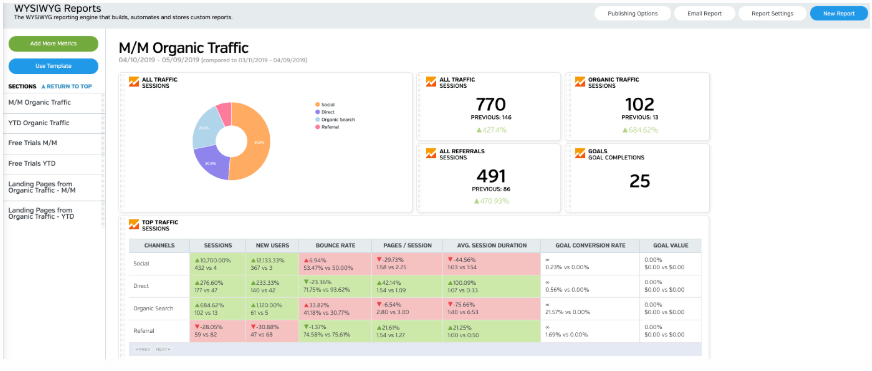
White Labeled and Branded Reports. Drag and Drop Editor. Automate your SEO, PPC, Social, Email, and Call Tracking Reporting.





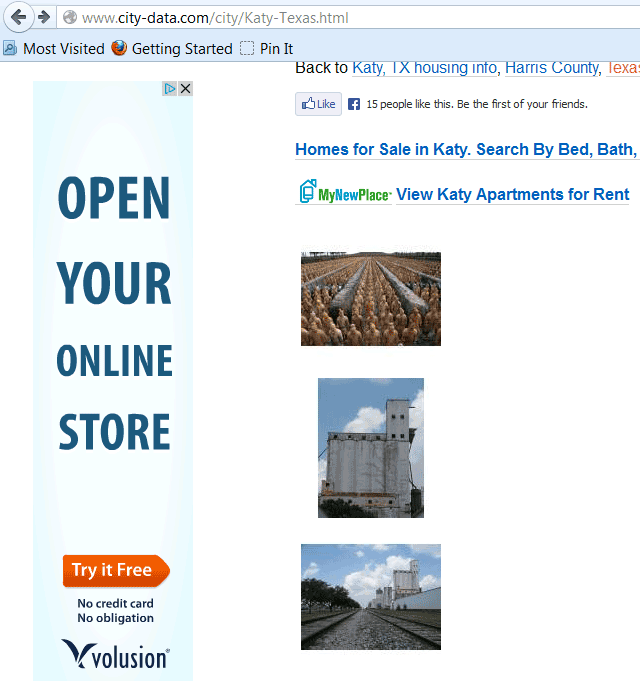


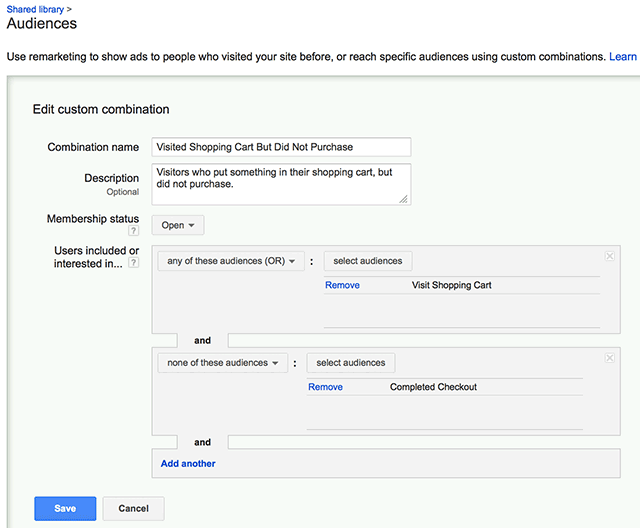


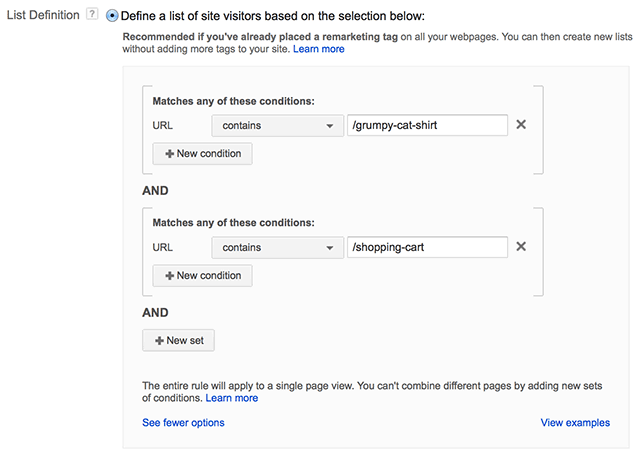
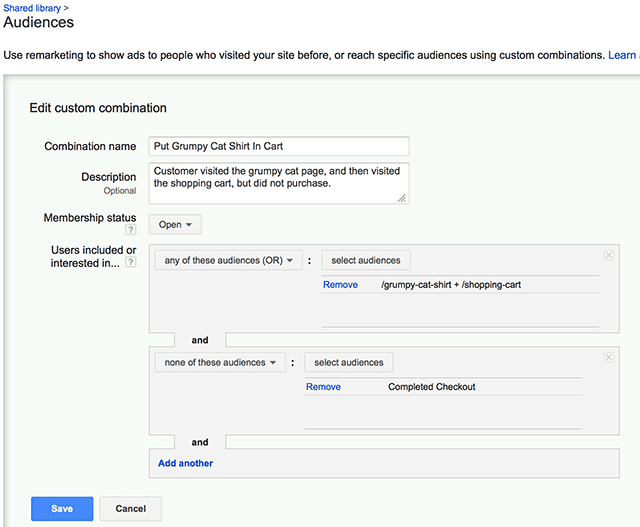
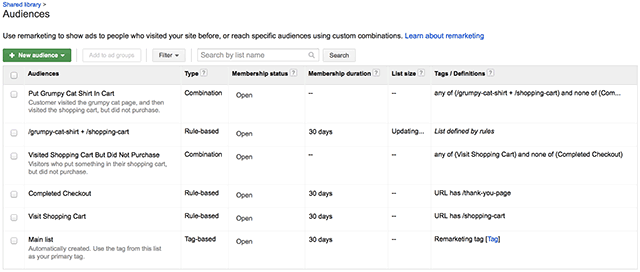



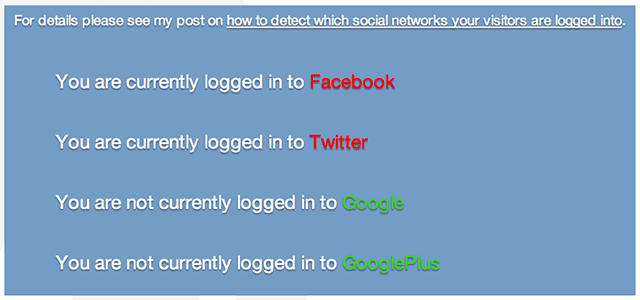
You didn’t specifically mention it (I think)… the remarketing code can be on another domain. All sorts of ideas spawn from that.
Absolutely, Pat. You could swap remarketing code with a website who shares a similar demo as your own, allowing you both to advertise to visitors of the other. Or just pay someone to host your tag on their site. Along the same lines, it should be pointed out that you can create remarketing lists from and target audience lists from any ad group within the same client ID.
Some very good stuff here. Love the tool that allows to see if a user is signed into social.
Thanks Vinny!
good job Sean. most comprehensive write up of remarketing list segmentation ideas i’ve ever seen!
Thanks Larry!
Great post Sean, so many cool idea to do a more segmented retargeting campaign ! We’re absoloutely gonna try some of these !
I’d add that social retargeting like on Facebook is quite new and there are yet few advertisers so you can get really low prices and an overall amazing ROI. AdRoll ceo was talking about this in a recent panel at AdTech San Francisco and he showed some impressive numbers !
Thank you! Really glad to hear you took something away from it. Great point on jumping into Facebook retargeting sooner rather than later.
This was a great post, Sean! You could also create a list for site visitors that have scrolled to a certain point on a page. I know this is more difficult to implement than using time on page, but it’s often more accurate. A visitor who has scrolled all the way to the bottom of your blog post, could be someone worth targeting.
Excellent piece. Really got the creative juices flowing. I’ve got an interesting idea for the last suggestion around showing weather-dependent ads. There’s an AdWords add-on you can use called Weather Fit by Fast Web Media. I’ve blogged about it before on Econsultancy. It would allow for automatic remarketing placements based on real time weather data. Bingo. No need to be constantly looking out the window to check the weather!
Thank you Jason. That’s a great point, and it makes sense that scrolling down would prove engagement more than time-on-site. Great idea. I’m no developer, but this looks promising: http://stackoverflow.com/questions/8687978/on-scroll-down-how-to-make-ajax-call-and-get-the-respone-data
Simon, thank you! That’s brilliant stuff. I overheard something about weather automation at a recent conference, but I didn’t know who to credit the idea to. I love it. Ice cream, water park, ice rink, ads when temperature is greater than XX degrees. Turning ads to your restaurant off when it’s raining, due to the decreased likelihood anyone will leave their home. Sell exterior paint only when it’s above a certain temperature appropriate for painting. On and on.
Is it possible to trigger the pixel only after certain criteria… lets say… after 45 seconds the pixel activate… I am thinking to use like that in a blog, so I can only capture people how is reading the page for a while and not the people that didn’t like what the saw… I was looking for a wp plugin, for Google and Facebook, but I couldn’t find one that have this on it…
Great question. Yes, this is possible. Assuming that your Analytics account is connected to your Adwords account, you’ll want to create a duration goal (Type: Duration) in Analytics, and call that goal “[Blog Article] > 45 Seconds” and follow the duration settings instructions. Once that goal is created, go into Adwords, click on tools, then conversions. On the left sidebar you’ll see the option for Google Analytics, where you can enable your goals. These goals now have their own unique tags and can be used to create marketing lists based on the criteria of the goal.
I’m glad to see you still respond to questions 3 years later. Can you create lists to show different banner ads to people who have visited a 2nd time and then if they visited a third time a 3rd banner set?
This is an amazing blog! Some of the best re-marketing tips I’ve come across
thank you for that – you certainly got my creative juices flowing. I am always looking for inventive ways of marketing my products and services to my existing clients. I like the email marketing campaigns that are offered by top-tier service providers like Criteo. I’ve also seen some good work done at Adroll. One video remarketing company that is making a lot of waves at the moment is Treepodia. It looks fantastic and their videos are highly effective as well. Which of these three have you worked with, and you recommend any of them?
Dieser Post mag schon ein paar Jahre alt sein, aber es sind einige super Ideen darin enthalten. Ich habe she gute Erfahrungen mit dem Video Remarketing von Treepodia gmacht, die meine Kunden für Produkt-Videos und ähnliches begeistert haben. Die Möglichkeiten in Twitter, Facebook und Google für Video-Marketing sind schon toll. Vor allem Facebook. Es hat sich viel getan seit dem Post in 2013. Video Remarketing ist nun hipp und die Effizienz in Sachen Konversion lässt sich in Analytics ablesen und prüfen.